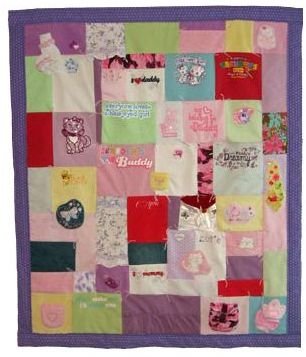Quilting Using Recycled Material
Green Quilting
One way to go green is by recycling as many items as you can on your own. When you use items that you already have, you can save money and can give new life to old items that would otherwise just be thrown away. An excellent example of this is used by the green crafting movement. Craft items such as scrapbooks, bags, blankets, curtains and even gifts boxes are being created through the use of recycling household items. Quilts and quilting art is another craft area that has gone greener with the use of recycling old clothes, sheets and curtains more than purchased fabrics.
Here we are going to take a look at one of the more popular green ways to quilt and that is by using old clothes. Quilting using recycled materials like old clothes serves two main purposes. The first purpose is in saving money by not purchasing commercial made fabrics. The second purpose is in using old clothes to create quilts you can make memories that showcase the favorite colors and fabrics of the people who used to wear them.
Recycle Old Clothes
Many people have started fabric collections of either their own old clothes or the old clothes that children have grown out of. To begin this process, the first step would be to clean out those closets and drawers. Look for clothes that are no longer worn, items that have gone out of style or have been grown out of altogether. Kids clothes, though small can offer a good opportunity to have a collection of accent fabrics full of colorful characters. T-shirts can also provide a great selection of printed patterns, while recycling old denim can give a quilt a sturdy and long lasting use life.
Once you have created a pile of clothes to use as recycled material, the next step is to separate them by fabric types. Fabrics that have some stretch to them such as t-shirts and socks will need to be worked a little differently than stiffer or thicker fabrics like denim or wool. Personal preference also comes into play when organizing the fabrics that have been collected as some quilters will create fabric piles by color, pattern or by the person who the old clothes have come from. An example of separating fabrics by person would be in creating a child’s quilt made out of their own old clothes.
An excellent example of what can be done by recycling old children’s clothes is shown above and to the left. The quilt was created from out grown little girls clothes and was crafted by quilter Jamie of Jelly Bean Quilts. Click on the image to open a larger view in a new window.
Recycle Paper and Cardboard for Making Patterns
Another way to get green in pattern creation for making recycled material quilts is to use items around the house. For instance, old cereal boxes from the cupboard can be recycled as can old paper when making shapes for quilting. Hexagons, squares, triangles and circles can be cut out and used as guides to cut the shapes out of the fabrics that have been collected.
The method for doing this is an old style called patchwork quilting. In this form for pattern creation, you use foundation piecing for creating the basis of the quilt. To do this you first need to pick your shape and size that you what the shape to be. Then cut the shape out of paper or cardboard several times to give yourself a starting base of five or ten shapes.
Pin the shapes to your fabrics and then cut the fabric out around the shapes. Leave a little fabric around the edges of the shape and then re-pin the fabric to the shape. Once you have a certain number of shapes done in this way then you can begin to sew the pieces together. Some people keep the paper or cardboard shapes in the fabric and then rip them out after they are sewn together and then make more shapes to piece together. Others take the paper and or cardboard out before sewing the pieces together. Whichever way you want to sew your quilt together is all due to personal preferences. For more information on creating patchworks and quilting using recycled material with various patterns and templates, visit the World Wide Quilting group’s Foundation Piece Blocking page.
